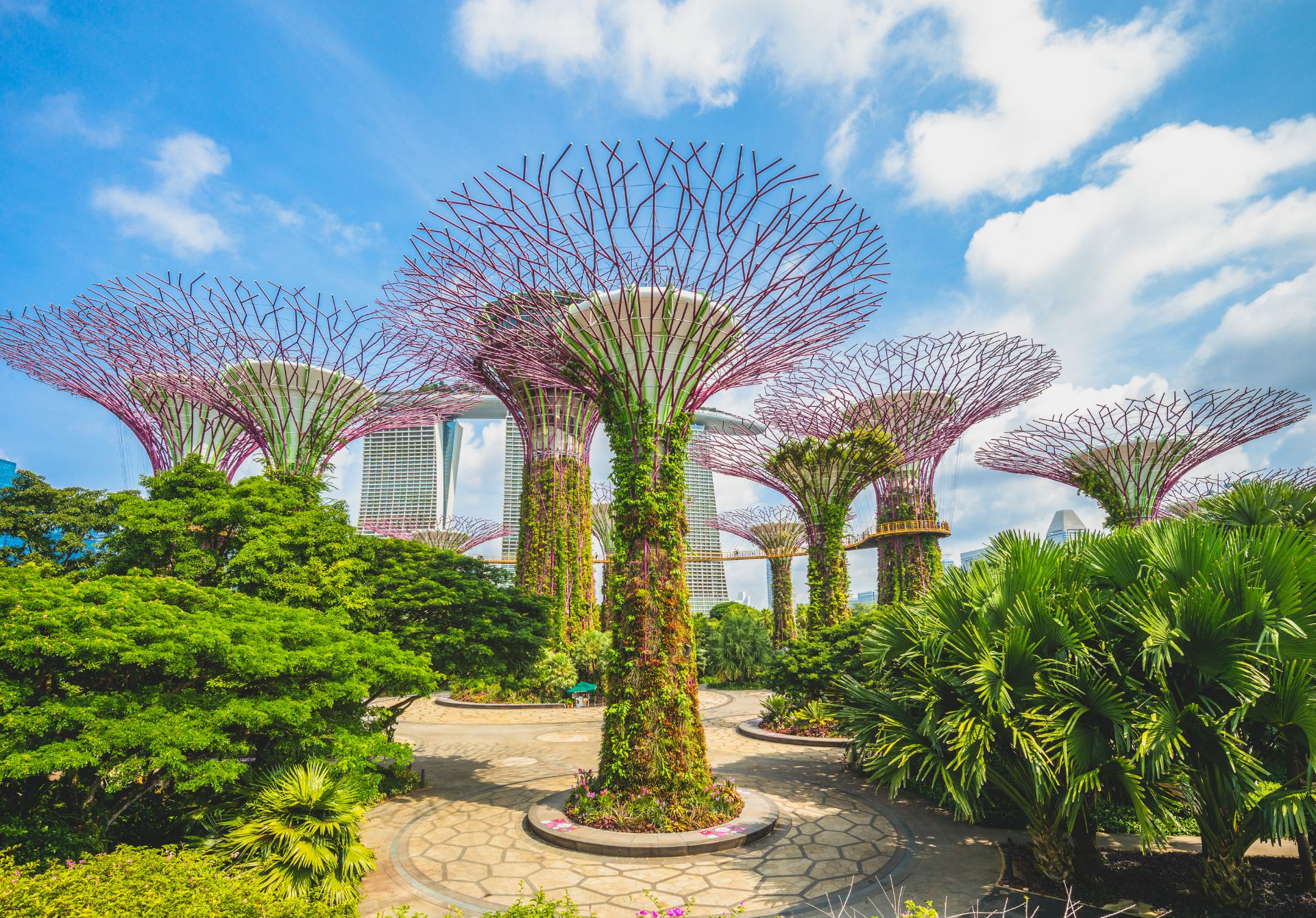Nestled in the heart of Singapore’s bustling Marina Bay area, Gardens by the Bay stands as a testament to the city-state’s commitment to becoming a “City in a Garden.” This architectural and horticultural marvel has captivated visitors from around the world since its opening in 2012, offering a unique blend of nature, technology, and sustainable design.
A Vision of Green Innovation
Gardens by the Bay was conceived as part of Singapore’s national strategy to enhance the quality of life for its citizens by increasing green spaces in the urban environment. Spanning 101 hectares of reclaimed land, this ambitious project has transformed Singapore’s waterfront into a lush paradise that showcases the beauty of nature and the ingenuity of sustainable architecture.
The Iconic Supertrees
Perhaps the most recognizable features of Gardens by the Bay are its towering Supertrees. These vertical gardens, ranging from 25 to 50 meters in height, are not merely aesthetic marvels but also serve crucial environmental functions:
1. Vertical planting: Each Supertree is home to over 200 species of bromeliads, orchids, ferns, and tropical flowering climbers. 2. Environmental sustainability: The Supertrees are equipped with photovoltaic cells to harness solar energy, which is used to illuminate the structures at night. 3. Rainwater collection: The Supertrees collect rainwater for use in irrigation and fountain displays throughout the gardens. 4. Air intake and exhaust functions: Some Supertrees are integrated with the park’s conservatories, helping to maintain their internal environments.
Conservatories: A World of Wonder
Gardens by the Bay features two stunning conservatories that transport visitors to diverse climatic regions:
1. Flower Dome
Recognized by the Guinness World Records as the largest glass greenhouse in the world, the Flower Dome replicates the cool-dry climate of Mediterranean regions. It houses a vast collection of plants from five continents, including baobabs from Africa, olive trees from Spain, and succulents from the Americas.
2. Cloud Forest
This misty conservatory recreates the tropical montane environment, complete with a 35-meter indoor waterfall – the world’s tallest indoor waterfall. Visitors can explore the diverse vegetation of tropical highlands up to 2,000 meters above sea level, learning about rare plants and the impacts of climate change on these delicate ecosystems.
Sustainable Design and Technology
Gardens by the Bay is a prime example of sustainable urban development, incorporating numerous eco-friendly technologies:
– Energy-efficient cooling systems in the conservatories that use chilled water pipes running through the ground – A biomass co-generation system that converts horticultural waste from the gardens and other parks in Singapore into energy – Rainwater harvesting systems that help meet the gardens’ irrigation needs – Use of lake systems for natural cooling and irrigation
These innovations have earned Gardens by the Bay numerous accolades, including the World Building of the Year at the World Architecture Festival 2012 and the President’s Design Award in Singapore.
Educational and Cultural Impact
Beyond its aesthetic appeal, Gardens by the Bay serves as an important educational resource:
– The gardens offer guided tours, workshops, and interactive exhibits that educate visitors about biodiversity, climate change, and sustainable living. – The “Children’s Garden” provides a dedicated space for young visitors to learn about plants and the environment through play. – Regular events and festivals, such as the “Christmas Wonderland” and “Mid-Autumn Festival,” celebrate cultural diversity and attract both locals and tourists.
Economic Contributions
Gardens by the Bay has become a significant contributor to Singapore’s tourism industry:
– In its first year of operation, the gardens welcomed over 6.4 million visitors. – By 2018, it had attracted over 50 million visitors, generating substantial revenue for the local economy. – The gardens have created numerous jobs in horticulture, hospitality, and education sectors.
Future Developments
As Gardens by the Bay continues to evolve, plans for future expansions and improvements include:
– The development of a new waterfront promenade – Expansion of educational programs and research facilities – Implementation of new technologies to further enhance sustainability and visitor experiences
Gardens by the Bay stands as a shining example of how urban development can harmonize with nature, creating spaces that are not only beautiful but also educational and sustainable. This horticultural wonder has redefined Singapore’s skyline and serves as a model for green urban planning worldwide. As it continues to grow and evolve, Gardens by the Bay remains a testament to Singapore’s vision of a city where nature and technology coexist in perfect harmony, inspiring visitors to appreciate and protect our planet’s precious ecosystems.

